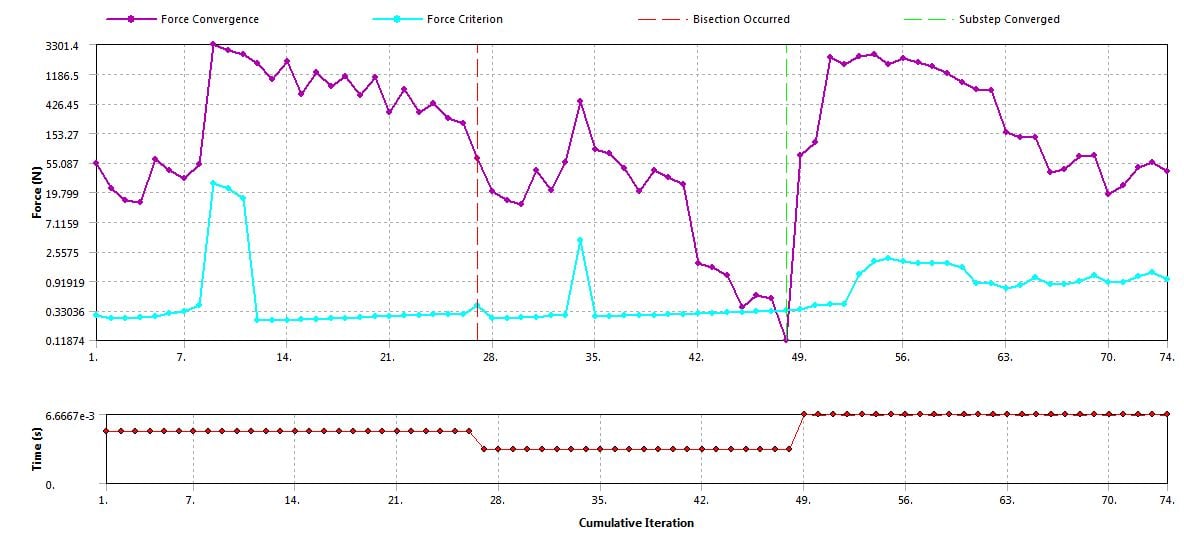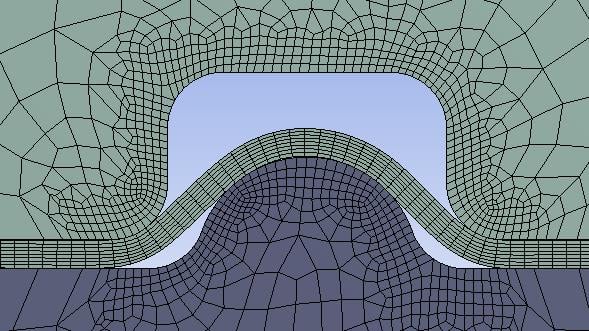-
-
September 7, 2018 at 10:24 pm
rmknox
SubscriberHi everyone,
I'm running a compression-shear analysis on a spinal fusion device and am unable to get the solution to converge long-term. What I mean by that is an individual substep will converge, then the solution loses convergence on the first iteration of the next substep. I've included an image below to show what I mean.
I've run this simulation many times using different parameters with similar results. In several cases, multiple substeps will converge, but the solution will always lose convergence in the iteration immediately following the converged iteration.
Is this a problem that can be fixed simply by adding more substeps? More generally, does this pattern (converged substep followed by immediate loss of convergence) indicate a particular solution?
I am happy to provide any further information as necessary. Thank you in advance for your help.
-
September 7, 2018 at 10:31 pm
Sandeep Medikonda
Ansys EmployeeHi, Can you explain what kind of analysis you are doing? and provide details on the materials in use, the Analysis and Contact settings?
Regards,
Sandeep -
September 7, 2018 at 11:21 pm
rmknox
SubscriberHi Sandeep,
I'm running a Transient Structural analysis of a spinal fusion device under compression and shear. I'm defining by substeps, minimum = 200, initial = 400, maximum = 500. Large deflection is turned on.
All contacts are frictional with COF = 0.3 and Adjust to Touch interface treatment. I've also performed local Contact Sizing mesh refinements at all frictional contact areas.
I'm using custom permutations of Ti6%Al4%V for my materials.
I hope this helps!
-
September 8, 2018 at 12:11 am
Sandeep Medikonda
Ansys EmployeeWhat is the exact error you are seeing? Are you seeing pivoting error or errors related to a certain degree of freedom (DOF) exceeding limits? If so, please see this post. You
Any reason why you aren't using Static Structural?
Lastly, have you checked for the Newton-Raphson residuals and checked if the contact is causing the problem? Also, use the initial contact tool and check for the pinball radius, make sure it is large enough to enclose the contact gaps.
If you are still having problems, Can you post images and explain when you reply?
Regards,
Sandeep -
September 8, 2018 at 12:37 am
peteroznewman
SubscriberHave a look at these videos to see how to use the information in a Newton-Raphson residual plot to aid in convergence.
Regards,
Peter -
September 10, 2018 at 9:16 pm
rmknox
SubscriberHi Sandeep,
I've posted the error message I receive here:
Unfortunately, it doesn't reference DOF errors or any other problems I've seen elsewhere online.
Regarding contacts, the initial status for each contact pair is Closed. It seems like the Pinball for each region is large enough to enclose any penetrations or gaps, I've included a picture of the initial information screen below:
We tend to use Transient Structural over Static Structural because we've had more success using it for our applications in the past. I can try to redo everything using Static Structural to see if that helps at all.
I have several Newton-Raphson residual plots active. The frictional contact areas are definitely where the trouble is arising. I'll be sure to use Peter's video suggestions to look deeper into this.
Thank you!
-
September 10, 2018 at 10:42 pm
Sandeep Medikonda
Ansys EmployeeHave you tried these suggestions from the manual:
- Check for sufficient supports to prevent rigid body motion or that contact with other parts will prevent rigid motion.
- Check that the loading is of a reasonable nature. Unlike linear problems whose results will scale linearly with the loading, advanced contact is nonlinear and convergence problems may arise if the loading is too big or small in a real world setting.
- If the contact type is frictionless, try setting the type to rough. This may help some problems to converge if any possible sliding is not constrained.
- Check that the mesh is sufficiently fine on faces that may be in contact. Too coarse a mesh may cause inaccurate answers and convergence difficulties.
- Consider softening the normal contact stiffness KN to a value of .1. The default value is 1 and may be changed by setting the Normal Stiffness. Smaller KN multipliers will allow more contact penetration which may cause inaccuracies but may allow problems to converge that would not otherwise.
- If symmetric contact is being used (by default the contact is symmetric), consider using asymmetric contact pairs. This may help problems that experience oscillating convergence patterns due to contact chattering. The program can be directed to automatically use asymmetric contact in the Details view of the Contact Folder.
-
September 17, 2018 at 8:44 pm
rmknox
SubscriberHi Sandeep,
I was able to get the simulation to solve by running it in Static Structural. Thank you for your suggestions, I will be sure to keep them in mind in the future.
-
November 27, 2019 at 2:05 pm
marsicano1
SubscriberHi everyone!!
I am running a bulge test simulation.
My problem is that the solution does not converges and a warning about the solver pivoting appears.
Could you give me a hand pleace?
I attach my file.
Thanks in advance
-
November 27, 2019 at 5:10 pm
peteroznewman
SubscriberHi Marsicano,
Thank you for deleting your post out of the discussion that had nothing to do with your question.
This discussion is relevant to your question. Did you read all the advice in this discussion?
It is still better for you to start a New Discussion using the big green button at the top right of this page. I have put an image of that below.
The reason is that the member who starts a discussion gets automatic email notification of new posts, if they check that box. So in this discussion, that is rmknox and not you.
In your New Discussion, you can put a link in your post that you have read this relevant discussion and it didn't help you to solve your problem. You do that by right mouse click on a #Permalink on any post in this discussion and Copy link address (if using Chrome). Then you can paste that link in your post by clicking on any word in your post and using the Link button to insert a link. Then you paste.
-
November 28, 2019 at 1:08 am
peteroznewman
Subscriber -
November 28, 2019 at 5:59 pm
marsicano1
SubscriberHi Peter!!!
Many Thanks for your help!!!!
Unfortunately when I open your file, the software gives me a message.
As you suggested me I opened a new discussion.
Could you help me?
-
November 12, 2020 at 4:12 am
pravallikalikith
SubscriberHai peter,n I am doing transient structural analysis for my piezoelectric model. When I run the simulation, solution is converging very slowly and sometimes failed to converge. I have tried the possibilities what you have posted earlier. please suggest me how to resolve.n -
November 14, 2020 at 2:24 am
peteroznewman
SubscribernIf your solution is converging, that is good. Some solutions take a long time. There are ways to speed them up.nIf your solution fails to converge, use the things you have read about to get them to converge.nI have no suggestions, you have not provided me with anything to look at.nn -
November 17, 2020 at 6:43 am
pravallikalikith
SubscriberHi peter,n My solution is converging successfully but it is taking a lot of time (2-3) days. How to speed up the simulation? My model is having 4,57,238 mesh elements and 19,313,248 nodes. Apart from reducing the number of elements, please suggest me how to do?nthank you.nWith regards.n
-
- The topic ‘Solution failed to converge – loss of convergence’ is closed to new replies.


- LPBF Simulation of dissimilar materials in ANSYS mechanical (Thermal Transient)
- Convergence error in modal analysis
- APDL, memory, solid
- Meaning of the error
- How to model a bimodular material in Mechanical
- Simulate a fan on the end of shaft
- Real Life Example of a non-symmetric eigenvalue problem
- Nonlinear load cases combinations
- How can the results of Pressures and Motions for all elements be obtained?
- Contact stiffness too big

-
4167
-
1487
-
1338
-
1188
-
1021

© 2025 Copyright ANSYS, Inc. All rights reserved.













